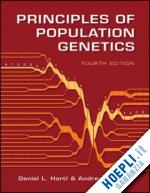Published by Sinauer Associates, an imprint of Oxford University Press. Principles of Population Genetics, Fourth Edition, is a thoroughly updated introduction to the field that is at last ascending to its rightful position of centrality to evolutionary genomics and human genetics. Rapid and inexpensive genotyping and sequencing have produced a profusion of data on genetic variation, along with a pressing need to inform students from many fields about the models that describe the underlying processes that give rise to observed patterns of genetic variation. This book provides a balanced presentation of theory and observation for students at the undergraduate and graduate levels as well as newcomers from fields like human genetics. The logical development of the models of population genetics encourages a deeper understanding of the principles, and the text has been rewritten with the goal to optimize its use as a teaching aid. It introduces the principles of genetics and statistics that are relevant to population studies, and examines the forces affecting genetic variation from the molecular to the organismic level. Integrated throughout the book are descriptions of molecular methods used to study variation in natural populations, as well as explanations of the relevant estimation theory using actual data. Chapter 1 presents the fundamental observations and means for quantifying amounts and structure of genetic variation in natural populations. Chapter 2 gives a detailed examination of the implications of random mating for one locus and multiple loci and establishes the basic principles for thinking about mathematical models of variation. Chapter 3 presents the classic Wright-Fisher model as well as the coalescent approaches to random genetic drift. Chapter 4 adds mutation to models of drift and lays down the foundations for the neutral theory of molecular evolution. Natural selection in its many guises gets a thorough coverage in Chapter 5. Chapter 6 examines population subdivision and its consequences for the distribution of genetic variation among subpopulations, including the hierarchical F statistics used in estimating these effects. Molecular population genetics, including applications of coalescent theory, is the subject of Chapter 7. Evolutionary quantitative genetics is covered in Chapter 8, including an up-to-date treatment of the use of molecular markers for mapping and assisting in selection of quantitative characters. Chapter 9 is a new addition and covers the exciting field of population genomics, or the analysis of population genetic principles at a genome-wide scale. Finally, because of the explosion in genome-wide polymorphism data in humans and the realization that many problems in empirical population genetics need to be tuned to special, non-equilibrium circumstances of human populations, the authors devote Chapter 10 to human population genetics. Applications of principles discussed in the text are illustrated with numerous examples of worked problems, using actual data. Many vital Web links are scattered throughout the text to connect the material to up-to-the-minute progress in this exciting field. Each chapter ends with a complete summary and offers several problems for solution, to reinforce and further develop the concepts.












